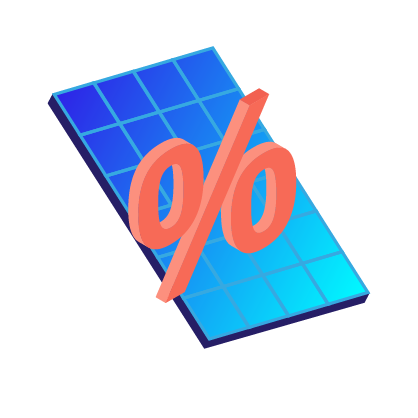What Are Solar Panels Made Of?
You might know what solar panels can do – convert sunlight into energy, save money, create energy independence, increase your home’s resale value – but how do they do it? What are solar panels made of?
What are solar panels made of?
Most solar panels are made of a collection of silicon solar cells in a metal frame that are protected by a glass sheet. They also include wires and metal ribbons called busbars to transport the electrical current out of the panel and into your home.
Let’s take a look at each component that makes up a solar panel.
Silicon in solar panels
Around 90-95% of solar panels are made of silicon semiconductor solar cells, often called photovoltaic (PV) cells.
In each cell, silicon is used to make negative (n-type) and positive (p-type) semiconductors, which are layered on top of each other. Electrons pass between the two layers and, when struck by photons from the sunlight, are knocked free to create an electrical current.
Solar manufacturers add boron, gallium, and phosphorus to silicon to give the solar cells different charges.
Why use silicon to make solar cells?
Silicon has been used to make solar cells since the 1940’s, when solar cells were first being researched in Bell Labs, and is still being used today. There are several reasons for this:
- After oxygen, silicon is the most abundant element in the Earth’s crust. Its sheer abundance helps to keep the cost of panels low
- Silicon has a high conversion efficiency that allows more sunlight to become electricity
- Silicon is durable, which allows solar panels to be warrantied for 25+ years
- Silicon is non-toxic and safe to work with
Monocrystalline vs polycrystalline solar cells
There are two forms of crystalline silicon panels: monocrystalline and polycrystalline. Monocrystalline solar cells consist of wafers cut from one large, pure crystal, and tend to have higher levels of effiency. Polycrystalline solar cells are made by melting multiple crystals together in a vat and are less efficient and less expensive than monocrystalline panels. You can find out more about mono- and polycrystalline panels on our blog post here.
Aluminum in solar panels
Aluminum is used for two components of solar panels: Busbar wiring and metal framing.
Busbar ribbon fills the space between solar cells and allows electricity to flow throughout the panel. The more busbar ribbon, the greater the efficiency of the panels.
Aluminum is also used make the metal frames that surround solar panels. These frames protect the panel from environmental elements and are used to mount the panels.
Glass in solar panels
The clear top of a solar panel is typically a thin layer of glass, about 6-7 millimeters thick. The glass casing not only protects the solar cells from falling objects, it regulates heat and humidity within the panel.
Glass accounts for roughly 97% of the weight of a solar panel — making it by far the biggest component of a solar panel, by mass. It’s perfectly suited for solar panels because it is cheap, durable, and easy to recycle.
Other materials in solar panels
While silicon, glass, and aluminum make up the primary components of a solar panel, there are other materials used as well. These include:
- A durable backsheet made from plastic
- Standard 12V wire
- Ethylene vinyl acetate (EVA) glue
Related Reading: How To Choose Solar Panels for Your Home
Are solar panels recyclable?
The big question is what happens to those materials at the end of a solar panel’s life?
Solar panel recycling is absolutely a valid concern — as is the end-of-life scenarios for all energy infrastructure including wind, nuclear, and fossil fuels. But there are a few reasons to be hopeful that your solar panels won’t become waste after they are retired.
First, a 2022 study published in PLOS ONE found that solar panels are lasting much longer and the “wave” of solar panel waste will be much smaller and arrive about 10 years later than previously expected. That gives the solar recycling industry 10 additional years to improve the technology and infrastructure.
Second, solar recycling technology is already advancing at breakneck speed. Italian startup Tialpi already has a patented process for recycling 85% of a solar panels weight and has its sights set on achieving 100%. The process apparantely only requires 1 kW of electricity per panel — roughly 2.5 hours worth of production for a 400W panel.
And Tialpi is far from alone. The solar panel recycling market is expected to grow by over $300 million from 2022-2026 as more companies enter this space.
The bottom line
Solar panels are made from a combination of silicon, aluminium, glass, and various other materials. The abundance and durability of silicon and glass contribute to the cost of solar panels decreasing over the years.
Like all energy infrastructure, the end-life of solar panels should be considered to avoid creating waste. Solar panel recycling technology is in its early stages, but the durability of panels and rapidly expanding recycling market is promising.











